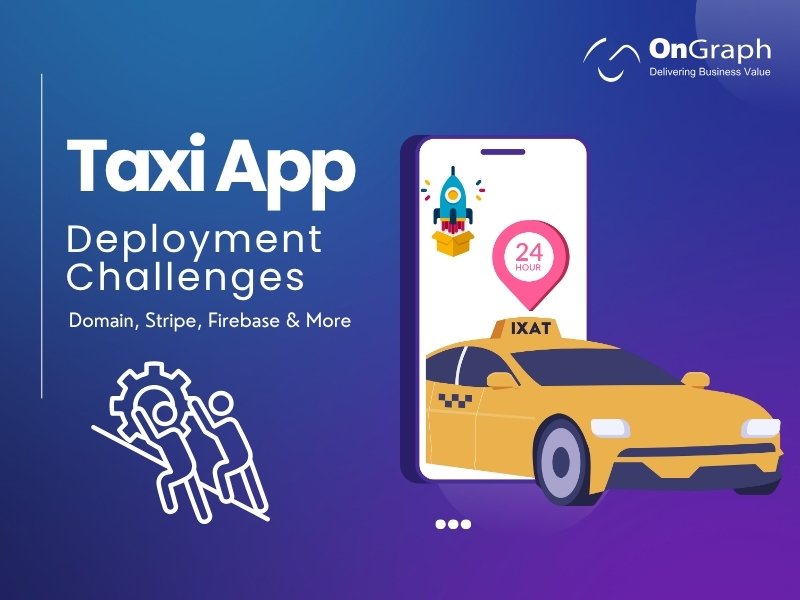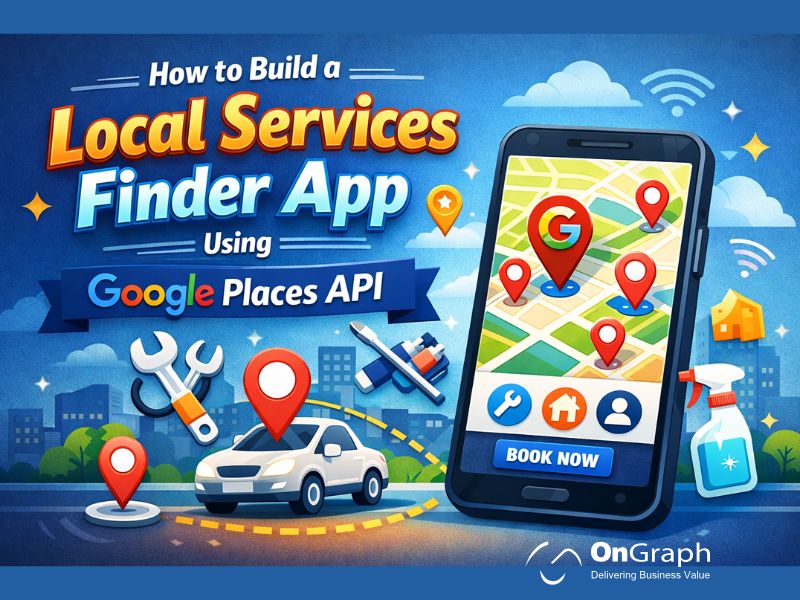In this article
- The Evolution of Taxi Apps: From Local Dispatch to Global Mobility
- Most Common Taxi App Deployment Challenges
- Taxi App Features That Require Proper Setup
- Real-World Example: From Setup Issues to Successful Launch
- What Is the Taxi App Development Cost?
- Final Thoughts
- Want to Launch Without the Headache?
Launching a taxi app might seem simple once you have the app built—but that’s often not the case. Many startups face taxi app deployment challenges that delay their go-live timelines. From setting up the domain and email, configuring Stripe and Firebase, to preparing Apple and Android developer accounts—each step matters.
This guide will walk you through common taxi app deployment issues and how to solve them, with examples, tools, and a real-world approach to help you launch faster and smoother.
The Evolution of Taxi Apps: From Local Dispatch to Global Mobility
Taxi apps have transformed from basic phone-based booking tools to full-featured digital platforms with maps, payments, and real-time tracking. According to Statista, the global ride-hailing market is projected to reach $226 billion by 2028, with much of this growth driven by localized apps in Africa, Southeast Asia, and mid-sized U.S. cities.
With such demand, many local car rental startups are now exploring app-based models. However, building the app is just one side of the coin—launching it without delays is where most stumble.
Most Common Taxi App Deployment Challenges
1. Domain and Email Setup
Setting up your domain is the first step toward building a strong brand. But many new founders struggle with:
- Linking a domain to a hosting account (e.g., AWS or GoDaddy)
- Setting up email using tools like Zoho, Gmail Workspace, or Outlook
- Configuring DNS records (MX, SPF, DKIM, DMARC)
Pro Tip:
Always verify domain and email configuration before Firebase or Stripe integration, since verification emails or app approval notices rely on this.
2. Stripe Account Setup for Ride-Hailing
Stripe is the most preferred payment gateway for taxi apps due to its reliability and global support. But setting up Stripe for ride-hailing involves extra steps:
- Registering as a transportation/mobility business
- Enabling payouts for drivers (split payments)
- Setting country-specific compliance (e.g., KYC for US, GST for India)
- Using correct URL for registration (e.g., stripe.com, not stripe.com/in if based in the US)
Example:
If you’re in the U.S., make sure your Stripe account is created using the stripe.com homepage. Using an incorrect regional URL might restrict features like payout management.
3. Firebase Setup for Taxi Apps
Firebase helps power your taxi app’s backend—authentication, notifications, crash reporting, and analytics. However, a wrong setup can cause:
- Push notifications are not working
- App not connecting to the database
- User login failure
- Crash logs are not being recorded
Checklist for Firebase Setup for Taxi Apps:
- Create a new Firebase project
- Enable Firebase Cloud Messaging (FCM)
- Download google-services.json and GoogleService-Info.plist files
- Link to iOS and Android bundle IDs correctly
- Connect Firebase to Google Cloud if you’re using Maps, Geolocation, or Cloud Functions
Case Study:
A startup had its rider app crashing on login. The reason? The Firebase package was missing the iOS plist file, breaking user authentication.
4. Developer Account Setup (Google & Apple)
Before you launch your app, you need developer accounts on both app stores:
- Google Play Console: One-time $25 fee
- Apple Developer Program: $99/year, DUNS number required
Challenges include:
- Waiting 7–10 days for Apple to approve the DUNS number
- Misconfigured app store descriptions or screenshots
- Country-specific banking/account verifications
Tip:
Start your developer account setup at least 2 weeks before your app is ready for deployment.
5. Onboarding a Taxi App Startup: A Step-by-Step Plan
Successfully onboarding a taxi app startup requires more than tech. It involves:
1: Lock branding – name, logo, domain
2: Register your business (LLC, GST, DUNS, etc.)
3: Set up payment (Stripe, PayPal, Razorpay)
4: Configure Firebase + Google Cloud
5: Create Play Store and App Store accounts
6: Upload driver and rider apps
7: Run test builds and UAT
8: Go live with pilot launch
This plan ensures that all moving parts are aligned with no last-minute roadblocks.
Fix Taxi App Deployment Issues Fast – Get Expert Help!
Taxi App Features That Require Proper Setup
Here are some taxi app features that depend on correct deployment:
| Feature | Setup Required |
| OTP Login | Firebase Auth + Phone API |
| Driver Tips | Stripe Connect Split Payments |
| Real-Time Tracking | Google Maps + Firebase Realtime |
| Push Notifications | Firebase Cloud Messaging |
| Subscription Model | Stripe Billing / In-App Purchase |
Real-World Example: From Setup Issues to Successful Launch
A mobility startup aimed to launch a local taxi app in the U.S. They had a working app but faced delays due to:
- Wrong Stripe account region
- Firebase is not linked with the iOS bundle ID
- DUNS number delayed by 9 days
- No developer access provided for app upload
With help from their taxi app development company, these issues were fixed in 3 days, and the app was launched within a week.
This example proves that launch issues aren’t always technical—they’re operational.
What Is the Taxi App Development Cost?
Taxi app development cost varies based on features, region, and level of customization. Here’s a rough estimate:
| App Type | Estimated Cost (USD) |
| White-Label App | $5,000 – $12,000 |
| Custom App with APIs | $15,000 – $30,000 |
| Multi-City Aggregator | $35,000 – $60,000+ |
Final Thoughts
Taxi app development is only half the battle—taxi app deployment challenges are what truly test your launch readiness. From domain setup to Stripe and Firebase configuration, each step demands attention.
If you’re looking to launch a taxi app for local car rental startups, work with a taxi app development company that not only builds but also helps you deploy successfully.
Want to Launch Without the Headache?
OnGraph has helped dozens of startups deploy their taxi apps with full Stripe, Firebase, and app store setup support. We guide you step-by-step, so you avoid common pitfalls and go live fast.
Launch Your Taxi App Smoothly with Us!
FAQs
The most common issues include:
1- Incorrect domain setup or missing DNS records
2- Incomplete or regional-restricted Stripe account setup
3- Firebase configuration errors (e.g., missing JSON or plist files)
4- Lack of developer accounts for the Play Store or App Store
5- Delays in getting Apple’s DUNS verification
6- SSL certificate or backend hosting issues
7- App build rejection due to missing permissions or screenshots
Step-by-step Firebase setup for taxi apps:
1- Go to firebase.google.com
2- Create a new project
3- Add Android/iOS apps using correct package/bundle IDs
4- Download google-services.json (Android) or GoogleService-Info.plist (iOS)
5- Add these files to your app’s root directory
6- Enable Firebase Cloud Messaging (for push notifications)
7- Connect Firebase with Google Cloud services if needed
Steps for Stripe account setup for ride-hailing:
1- Sign up at stripe.com (not the /in or /uk regional version)
2- Choose your business type: Transportation/Travel
3- Enable Stripe Connect (for driver payouts)
4- Add your bank details and KYC info
5- Request access for custom payouts and subscription billing if needed
6- Use API keys securely for payment integration
Domain and email are used for:
- App store verification emails
- Firebase or Stripe project registration
- Brand identity during app upload
Checklist:
- Buy your domain from a reliable registrar
- Set up custom email (e.g., support@yourapp.com)
- Add DNS records for SPF, DKIM, DMARC (email verification)
This helps improve athe pproval rate and avoids email delivery issues.
Yes. Many taxi app development companies like OnGraph offer full onboarding services that include:
- Stripe account guidance
- Firebase setup
- Developer account support
- Domain/email configuration
- SSL and backend hosting
This saves time, reduces errors, and speeds up go-to-market.
About the Author
Let’s Create Something Great Together!
Latest Blog
















